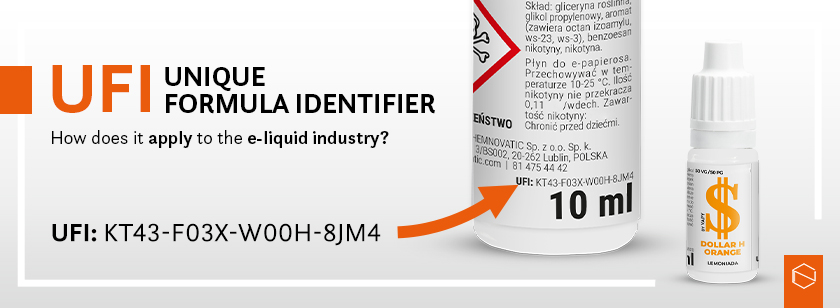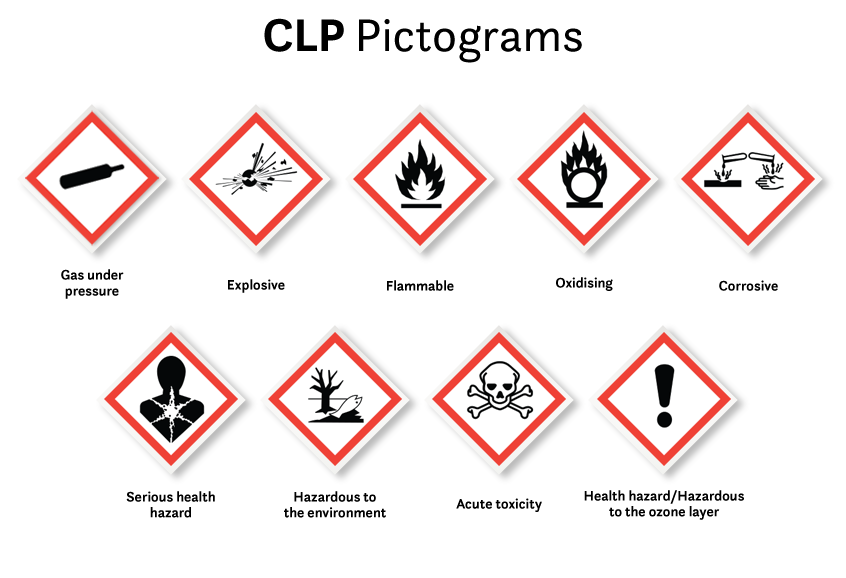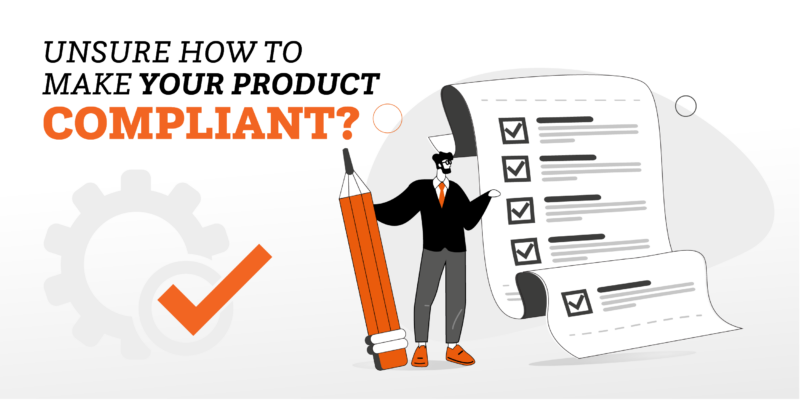When new regulations appear or one learns about the already existing ones, manufacturers often ask what they are for. As a matter of fact, the reason behind many laws is safety, just like in the case of UFI – a Unique Formula Identifier. What exactly is UFI and how does it apply to the e-liquid industry? Let’s find out!
Thanks to this article you will find answers for questions:
- What is UFI code?
- What is UFI code example?
- What areas and products does UFI apply to?
- Are there any exceptions regarding UFI?
- How does UFI registration process look like and what you need to conduct it?
Learn more:
- OEM Services And Private & White Label: 9 Reasons To Choose Chemnovatic As The Best Business Partner
- How To Start And Grow E-Liquid Brand?
- E-Liquid Regulations In The World
- E-Liquid Regulations Guide: [Get Your Free E-Book]
- E-Liquid Industry Regulations: REACH and CLP
- Tobacco Product Directive (TPD): All You Need To Know
- Fees, Taxes And More: An Analysis Of Selected Regulations In Europe
- Excise Duty In The Vape Industry [Guide]

What is UFI code?
As the definition says, the UFI acronym goes for the Unique Formula Identifier. It is a unique number that is present on the packaging of dangerous mixtures. UFI code consists of 23 or 24 characters, including spaces and dashes.
Each mixture has to be notified in the destination country, before being placed on the market. Each notification is related to a dedicated UFI code. Thanks to that, it is later easily searchable in National Toxicology Centres’ data bases which gather such data in case of poisonings or accidents.
To clarify the above definition, “placed on the market“, according to article 3.12 of Tobacco Product Directive, which includes e-liquids, it means:
supplying or making available, whether in return for payment or free of charge, to a third party. Import shall be deemed to be placing on the market.
Let’s also state what a dangerous substance is – according to the definition of the European Agency for Safety and Health at Work, it is:
any liquid, gas or solid that poses a risk to workers’ health or safety.
Dangerous substances and mixtures are also subject to the CLP (Classification, Labelling and Packaging) regulation. Thanks to that, they are easily recognized as the regulation states, they have to be marked with CLP pictograms on the packaging.
Learn more:
- What Is CLP?
- Nicotine Shots: Dealing With TPD Regulations
- TPD Compliant E-Liquid Packaging: Part 1
- TPD Compliant E-Liquid Packaging: Part 2
- E-Liquid Bottles Nozzle Requirements
- REACH: What Is Reach And Why We Talk About It?
- Storing And Handling Pure Nicotine And Nicotine Salts
- Safe Usage Of Chemicals [Guide]
What Is UFI Code example?
In your UFI code, the acronym ‘UFI’ (the same in all EU languages and alphabets, and not to be translated) must be in capital letters, followed by colon and a alphanumeric code. The code is divided into four blocks, each separated by a hyphen.
UFI code is present on the label of consumer products and there 3 possible variants of his looks:
- UFI:AUY1-C0WM-K005-3HF3 – 23 characters, including spaces and dashes
- UFI: AUY1-C0WM-K005-3HF3 – 24 characters, including spaces and dashes
- UFI: AUY1-C0WM
K005-3HF3 – 23 characters in 2 lines, including spaces and dashes
What areas and products does UFI apply to?
Unique formula identifiers apply to the European Economic Area (EEA). Aside from that, it also includes Norway, Iceland, and Lichtenstein.
Products that have to be UFI-notified are the ones placed on the European market. However, when manufactured in the EEA and exported abroad, this obligation does not apply unless one transfers them to a third party for storage before the products leave the EEA.
Moreover, repackaged or re-labeled products are also subject to UFI registration. The one to do it is the company responsible for the mentioned processes or the manufacturer if given the necessary data.
Learn more:
- E-Liquid Regulations In The World
- Fees, Taxes And More: An Analysis Of Selected Regulations In Europe
- Flavoured E-Liquids Banned In The Netherlands
- Law And E-Liquid Regulations In Denmark
- Vaping Regulations In Australia
- What Brexit Means For Vaping Industry?
- TPD-Registration Process In Germany: What Do You Need To Know?
- Non-Nicotine E-Liquids And E-Cigarettes Must Be TPD Notified In Germany
- TPD In Poland
As mentioned earlier, UFI regards dangerous mixtures. However, there are exceptions to it. Unique Formula Identifier does not require registration of gases under pressure, explosives, and those classified as hazardous to the environment.
Moreover, UFI does not include products used for scientific research and development, product and process-oriented research and development, and other mixtures exempted from the CLP classification obligations.
Although mixtures that fit the above criteria do not have to be UFI-registered, they may be reported to the authorities voluntarily.
If any questions arose up to this point, do not hesitate to contact us at sales@chemnovatic.com.
UFI Registration process
Who has to notify the product?
The obligation to register the products from the EEA, accordingly to UFI requirements, rests on the importers and formulators. The second group is units that create the final products, which are mixtures.
The distributors, who only store the UFI-subjected products and do not change the products’ composition, also have some obligations. They must provide information about which market they place products on, so the party that handles the registration can include this data. If the distributors do not do so, they will be obliged to register the products on their own.
Important aspects of UFI
When UFI registration is successful, the gained UFI code has to be placed on the labels of consumer and professional products. As for the products for industrial use, the code can be present only in MSDS. Keep in mind, that one product may have multiple UFI codes assigned to it.
What is required to conduct a UFI registration?
To correctly register a product, according to UFI requirements, one has to provide the necessary data. Let’s check some of the required information. Among them, there are:
- the list of countries, where the products will be placed on the market
- toxicological data
- intended use of the product in a given country
- colour and state of matter
As mentioned above, these are just exemplary requirements needed to acquire a UFI code. Aside from that, UFI registration may be paid for. For example, in Hungary, the price is 50 Euros per product, and in Italy, it’s 50 Euros per distributor, regardless of a number of products.
Check also:
- How To Start And Grow E-Liquid Brand?
- OEM Services And Private & White Label: 9 Reasons To Choose Chemnovatic As The Best Business Partner
- Pharmaceutical Quality Of E-Liquids: What You Should Know?
- E-Liquid Manufacturing Standards: Tips For Producers And Brand Owners
- E-Liquid Manufacturers: Best Practices
- Natural Vaping Products: Bases, Nicotine, Flavorings
- PG/VG Ratio: How To Find The Best For E-Liquids
- The Differences Between Glycol And Glycerine: When To Use Which?
Summary
UFI is an essential element of placing products on the markets, as it allows quick identification of their composition. Thanks to that, one can get fast medical help in case poisoning or accidents happen.
However, keep in mind, that aside from UFI, there are multiple regulations concerning the vape industry. It may be:
- REACH – Registration, Evaluation, Authorisation and Restriction of Chemicals
- CLP – Classification, Labeling and Packaging
- TPD – Tobacco Product Directive
Although some of their aspects may be complicated, they all serve a greater purpose – to bring the highest safety to the manufacturer, customer, and intermediate units, i.e., couriers.
UFI registration service
Complicated as UFI registration may be, we have conducted it multiple times. That’s why that matter is nothing new for the Chemnovatic Legal Regulations Department. We have the know-how on who, where, and when, shall register their product.
We have been in the vape and e-liquid sector since 2013. Dozens of clients have trusted us and we have launched over 200 products and brands.
That’s why, if you need any regulatory consultations, UFI registration service, help with TPD registration, or other services concerning the vape industry.
Use our resources and experience and together we will earn your success.
Contact us at sales@chemnovatic.com and let’s talk about your challenges and numbers!
Let’s grow your business together!
Subscribe to our newsletter and receive a free access to our e-mail course on raw materials for e-liquids production (and more!).
No spam, only valuable content we promise to send you.




















